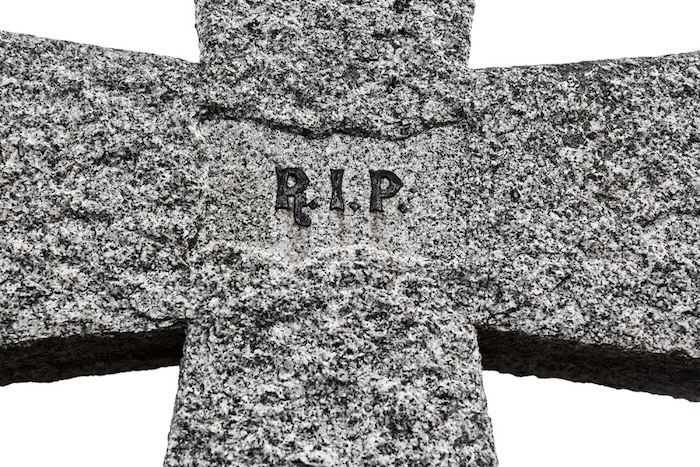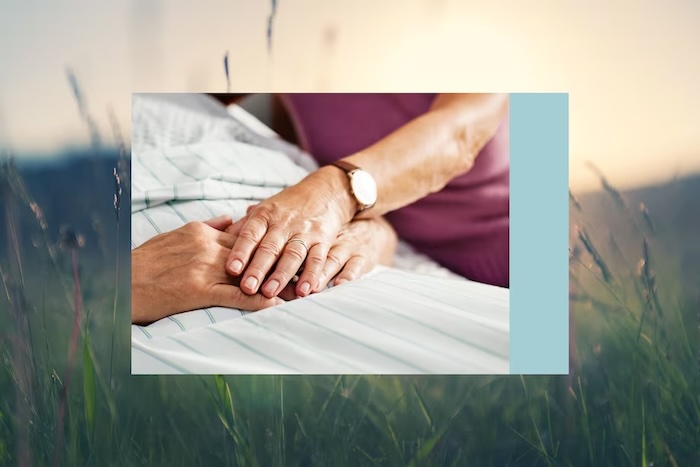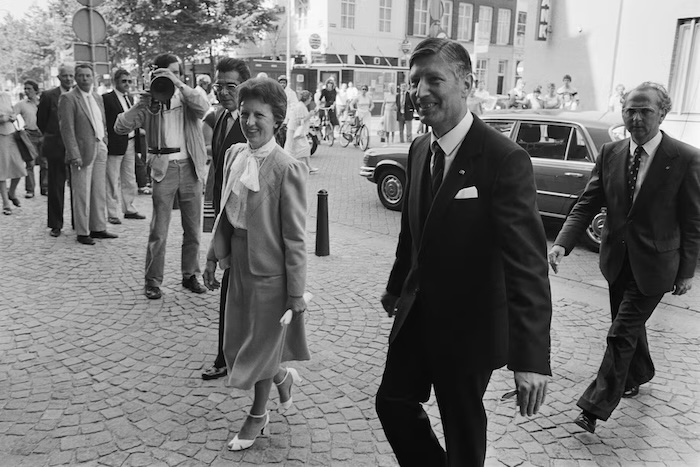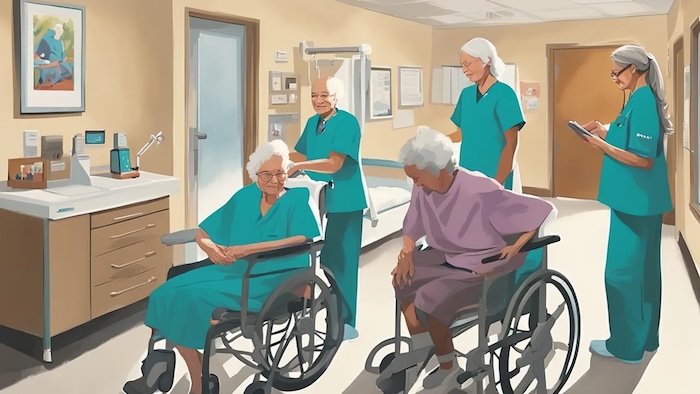— Here’s how they help patients go with grace.
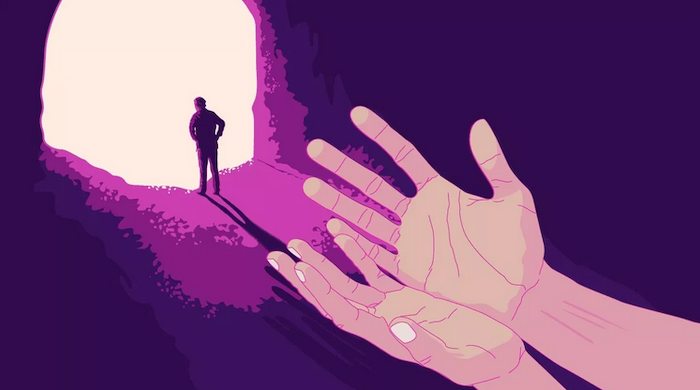
By Stacey Colino
What does it mean to have the “best possible death?” A growing number of end-of-life doulas are helping patients and families figure that out.
When Jerry Creehan was diagnosed with Amyotrophic Lateral Sclerosis (ALS) in January 2017 at age 64, he and his wife Sue knew they were facing a rough road ahead. For more than a year, Jerry had struggled with his balance and had been falling, unable to get up. ALS (formerly known as Lou Gehrig’s disease) is a progressive neurological disorder affecting nerve cells in the brain and spinal cord that regulate voluntary muscle movement, breathing, and other bodily functions; it eventually leads to paralysis and death.
In 2020, his condition began declining and he became reliant on eye gaze technology to move his wheelchair, and on a non-invasive ventilator to breathe. While attending a support group at the ALS Clinic at Virginia Commonwealth University, Sue heard Shelby Kirillin, an end-of-life doula, speak. Kirillin, a former nurse specializing in neurotrauma, spent two decades working in intensive care units, where she saw “how ill-prepared people are for the end of life. People don’t know how to talk to people with a terminal diagnosis. I thought we could do better.” That’s what inspired her to become an end-of-life doula in 2015.
“We knew we were in the final stages of ALS, and even though Jerry wasn’t afraid of dying, we needed someone to help us talk about it,” recalls Sue, a wound-care nurse consultant in Richmond, Virginia. “He wanted it to be the best possible death it could be, pain-free, and not filled with anguish.”
Many people are familiar with labor doulas, postpartum doulas, and maybe even abortion doulas, who provide support for people dealing with challenges related to ending a pregnancy. By contrast, end-of-life doulas work with those on the verge of dying, and their families. Also called death doulas, these professionals used to be rare but that changed during the COVID-19 pandemic. Since the virus began wreaking havoc, organizations that support and train death doulas in the U.S. have grown. In 2019, the National End-of-Life Doula Alliance (NEDA) had 260 members in the U.S.; membership grew to 1,545 doulas as of January 2024. Research has found that end-of-life doulas are most active in Australia, Canada, the United Kingdom, and the United States.
“During the pandemic, people were facing their own mortality more than at any other time because there was a lot of dying and grief happening,” says Ashley Johnson, president of NEDA, which is based in Orlando.
Offering various forms of support
Generally end-of-life doulas provide non-medical, compassionate support and guidance to dying people and their families. This includes comfort and companionship, as well as social, emotional, spiritual, and practical support (such as household help or running errands), depending on the provider’s strengths and the patient’s needs. Some end-of-life doulas help with estate planning, end-of-life care planning, or legacy planning. Others focus on helping people create an ambiance they want for their last days, facilitate difficult conversations between clients and their loved ones, or help with grief counseling with survivors.
“People don’t want to talk about death—they’re so afraid of it,” says Elizabeth “Like” Lokon, a social gerontologist who recently retired from the Scripps Gerontology Center at Miami University in Ohio and is now training to become a death doula. “As a social gerontologist, I want to bring it out from hiding and help people accept it. In some cultures, the denial of death, the separation between the dying and the living, is not as severe as in some western countries,” adds Lokon, who grew up in Indonesia.
“We labor into life, and we labor out of life,” says Kirillin. “All of us are born with life and death walking next to us.”
Changing the approach to death
Since it was formed in 2015, the International End-of-Life Doula Association (INELDA) has trained more than 5,600 doulas around the world, but the practice and training of death doulas varies considerably. There isn’t a universally agreed upon description of this type of care or federal regulations in the U.S. for becoming an end-of-life doula or oversight of their work. A study in the journal Health & Social Care in the Community concluded that the lack of a business model for death doulas creates inconsistencies in the services death doulas offer and what patients and their families can expect.
For example, INELDA offers a 40-hour training that focuses on the foundations of doula work and support for the dying. By contrast, NEDA is a membership organization that offers micro-credentials after doulas show their knowledge and proficiency in the skills involved. Other training programs offer four-week in-person courses, 12-week online courses, six-week programs, and other formats.
There’s also no standardized fee structure for end-of-life doulas: It typically ranges from $20 to $100 per hour, depending on the location and range of services that are offered, Johnson says. And some death doulas offer a sliding scale of fees or do it voluntarily, on a pro bono basis. Their services are not covered by insurance.
Regardless of how they’re trained or paid, many death doulas find the practice meaningful and fulfilling.
“People find it profoundly moving—some people use the word honor or sacred,” says Douglas Simpson, a trained end-of-life doula and executive director of INELDA. “End-of-life doulas help people take control of what their death looks like … It’s very fulfilling and not as depressing as people think.”
During the pandemic, Julia Whitty, a writer in Sonoma County, California, who had done volunteer hospice work earlier in her life, trained to become an end-of-life doula because her mother and a friend were on the verge of dying. She wanted to be better prepared personally, and she wanted to help other people with a terminal diagnosis in her social sphere.
“It’s a two-way relationship because you’re learning something from someone who’s coming to their end,” says Whitty, “and hopefully you’re helping them manifest what they want in their last days—physically, emotionally, socially, and spiritually.”
Among the things end-of-life doulas don’t do: administer medicine, monitor vital signs, make or recommend medical decisions for the client, impose their values or judgments on clients, or act as therapists.
“We meet people where they are—we come in holistically and help them navigate the final stages of life,” Johnson says. “It’s helping people face their own mortality with dignity. We’re promoting death positivity, decreasing the stigma.”
Creating a peaceful ending
Eleven months before he passed away, Jerry Creehan was put into hospice care and his wife Sue contacted Kirillin who worked with them once or twice each month for an hour at a time then more often as his condition deteriorated.
At first, Kirillin helped them talk about what death looks like and how Jerry could “own” his death. Sometimes she’d spend time just with Jerry, other times just Sue, and sometimes with both of them. As Jerry got weaker, Kirillin helped him come up with rituals to do with loved ones; she talked to Jerry about what he wanted his legacy to be and helped him write letters to loved ones. With Kirillin’s guidance, they created a detailed plan for his funeral and he designated personal belongings to be given to people he loved on his last night. Kirillin suggested they send an e-mail to friends and family members asking them to share memories and photos of time spent with Jerry.
“We got a wonderful response and put together a legacy journal,” recalls Sue who has three adult children and six grandchildren with Jerry. “I would read it to him, and it was very consoling to him to know that he had an impact on people’s lives.”
On his last evening, May 2, 2022, his breathing had become very difficult. There were 19 people in the bedroom, and someone opened a prized bottle of pinot noir to be used for communion with everyone present. Jerry was a certified wine educator, a foodie, an avid golfer, traveler, and a devout Christian, according to his wife of 46 years.
“He turned to me and said, Sweetie, I think it’s time,” she recalls. They kissed and hugged each other—family members helped put his arms around her—and Jerry said to Sue, “I love you. I always have and I always will. I’ll see you soon.” Then he winked at her and closed his eyes, she recalls. His ventilator was turned off and he passed away.
Afterwards, Kirillin and the hospice nurse stayed with him, bathed him, dressed him, and prepared his body for the funeral home.
“We did everything the way he wanted it to be done—that was a big gift to my family,” says Sue.
The Creehans’ experience isn’t unusual. In a study published last year in Palliative Care and Social Practice, researchers interviewed 10 bereaved family members about their experiences with a death doula and found that it was overwhelmingly positive. The most valuable benefit families gained was an increase in death literacy, including the ability to talk openly about death, which helped them feel empowered to care for their loved ones at the end of life. There was also a positive ripple effect as families spread the word about the benefits of using a death doula.
“People don’t want to wait for death to come and get them—they want to play the hand they were given the best they can,” Kirillin says. “We’re all going to die. I can’t change that. But I can help someone end the last chapter of their life the way they think they should. And I will sit next to them as they own it.”
Complete Article ↪HERE↩!



